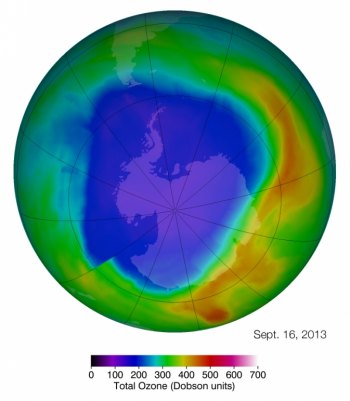NASA reports Antarctic ozone hole smaller than average this year

--NASA image
The agency announced on Oct. 25 that its satellite data showed the ozone hole that forms each year in the stratosphere over Antarctica was slightly smaller in 2013 than average in recent decades. “The ozone hole is a seasonal phenomenon that starts to form during the Antarctic spring (August and September),” according to a NASA news release. “The September-October 2013 average size of the hole was 8.1 million square miles (21 million square kilometers). For comparison, the average size measured since the mid-1990s when the annual maximum size stopped growing is 8.7 million square miles (22.5 million square kilometers).”
The agency added that the size of the hole in any particular year is not enough information for scientists to determine whether a healing of the hole has begun.
"There was a lot of Antarctic ozone depletion in 2013, but because of above average temperatures in the Antarctic lower stratosphere, the ozone hole was a bit below average compared to ozone holes observed since 1990," said Paul Newman, an atmospheric scientist and ozone expert at NASA's Goddard Space Flight Center in Greenbelt, Md.
The ozone hole forms when the sun begins rising after months of winter darkness, according to NASA. “Polar-circling winds keep cold air trapped above the continent, and sunlight-sparked reactions involving ice clouds and chlorine from man-made chemicals begin eating away at the ozone. Most years, the conditions for ozone depletion ease before early December when the seasonal hole closes.”
Ozone-depleting chemicals in the atmosphere have declined as the result of the 1987 Montreal Protocol, an international treaty to protect the ozone layer by phasing out production of ozone-depleting chemicals, the agency said. The size of the hole has stabilized, with variation from year to year driven by changing meteorological conditions.
The agency added that the size of the hole in any particular year is not enough information for scientists to determine whether a healing of the hole has begun.
"There was a lot of Antarctic ozone depletion in 2013, but because of above average temperatures in the Antarctic lower stratosphere, the ozone hole was a bit below average compared to ozone holes observed since 1990," said Paul Newman, an atmospheric scientist and ozone expert at NASA's Goddard Space Flight Center in Greenbelt, Md.
The ozone hole forms when the sun begins rising after months of winter darkness, according to NASA. “Polar-circling winds keep cold air trapped above the continent, and sunlight-sparked reactions involving ice clouds and chlorine from man-made chemicals begin eating away at the ozone. Most years, the conditions for ozone depletion ease before early December when the seasonal hole closes.”
Ozone-depleting chemicals in the atmosphere have declined as the result of the 1987 Montreal Protocol, an international treaty to protect the ozone layer by phasing out production of ozone-depleting chemicals, the agency said. The size of the hole has stabilized, with variation from year to year driven by changing meteorological conditions.
Related:

